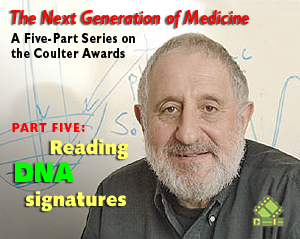Ideas and people behind the Coulter Awards
Mimicking DNA to identify bacteria

Part five of a five-part series
In November, the Coulter Foundation awarded the College of Engineering department of biomedical engineering a Translational Partnership Award of $2.9 million over five years to help biomedical technologies move from the lab bench to the patient bedside. Department faculty who found a clinical partner for their research were eligible to apply for the grant, and this year 18 teams started the process by submitting preproposals.
In this five-part series, BU Today looks at the projects selected for this year’s Coulter awards. In this, the final report of the series, we present a slide show about efforts to develop a means of identifying bacteria using targeted strands of a synthesized molecule that mimics DNA (peptide nucleic acid, PNA). The researchers behind the effort are Maxim Frank-Kamenetskii, an ENG professor of biomedical engineering, and Charles Lee, an associate cytogeneticist at Brigham and Women’s Hospital and an associate professor of pathology at Harvard Medical School.
The technology could give doctors and scientists an extremely specific and rapid means of detecting a wide array of bacterial diseases by synthesizing a “PNA opener” molecule that will bind only with specific microbial DNA signatures.
Click here to read yesterday’s installment, “New molecules that cushion joints.” Mark Grinstaff of ENG and Ilya Voloshin of MED are developing polysaccharide surrogates, which can be injected into joints and act as a cushion to further wear and tear.
Click here to read Wednesday’s installment, “Tiny devices, big diagnoses.” Catherine Klapperich of ENG and Satish Singh of MED are developing a credit-card sized diagnostic device that uses “microchannels” to isolate and analyze disease DNA.
Click here to read Tuesday’s installment, “Shining a new light on cancer.” Irving Bigio of ENG and Satish Singh of MED are using a fiber-optic probe to guide the diagnosis of cancer.
Click here to read Monday’s installment, “Glucose control without guesswork.” Ed Damiano of ENG and his wife, Toby Milgrome, a pediatrician at Worcester’s Fallon Clinic, create a wearable, automated glucose control system for type 1 diabetes.
Click here to read a Q&A with Coulter project director Arthur Rosenthal.